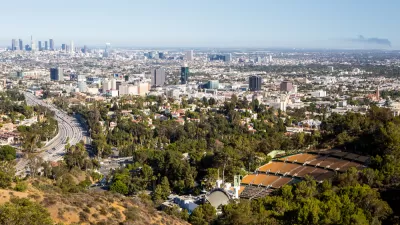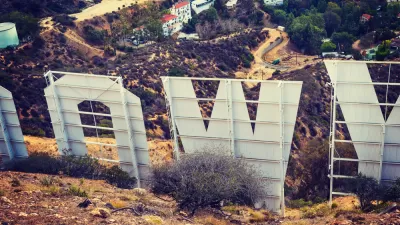Inspired by the controversial new Community Plan for Hollywood, The New York Times has invited six debaters to its opinion pages to offer their views on whether Los Angeles should "New Yorkify".
The debaters include authors, educators, bloggers, directors, and Bill Fulton (who has held seemingly every title in the planning profession).
First to Fulton, currently vice-president of Smart Growth America, who claims that the New Yorkification of LA is already happening, and will continue to, in areas well served by transit. And yes, he comforts, New Yorkers will still find plenty to complain about when comparing LA to the Big Apple, despite its increasing urbanization.
Cori Clark Nelson, blogger at Los Angeles I'm Yours, doesn't decry the concept of densification, but asks if there is a demand for it, and calls for improving mass transit as a more pressing priority.
Eric Avila, professor at UCLA, calls for new policies and priorities, to replace the unsustainable patterns of sprawl that gave rise to the city.
Perhaps it's best to leave the last word to Adrian Glick Kudler, senior editor of Curbed LA, who has one of the most reasonable arguments we've read in a while:
"The Hollywood Community Plan is not particularly groundbreaking. It doesn't touch parking requirements, it lowers height limits in a lot of places, and it really just tweaks floor area ratios (which dictate how big buildings can be relative to their lots). What it does is make sure that big buildings rise near transit stations, notes that historic buildings should be properly looked out for, and encourages pedestrian-friendly street improvements and new park development. It treats Hollywood like the urban center it's been for a long, long time, and it tries to make it a nice-looking, working urban center, for all the Angelenos who might want to live in that kind of place."
FULL STORY: Should Los Angeles New Yorkify?

Study: Maui’s Plan to Convert Vacation Rentals to Long-Term Housing Could Cause Nearly $1 Billion Economic Loss
The plan would reduce visitor accommodation by 25,% resulting in 1,900 jobs lost.

Placekeeping: Setting a New Precedent for City Planners
How a preservation-based approach to redevelopment and urban design can prevent displacement and honor legacy communities.

Using Old Oil and Gas Wells for Green Energy Storage
Penn State researchers have found that repurposing abandoned oil and gas wells for geothermal-assisted compressed-air energy storage can boost efficiency, reduce environmental risks, and support clean energy and job transitions.

Washington State Plans Ambitious ‘Cycle Highway’ Network
The state is directing funding to close gaps in its existing bike network and make long-distance trips more accessible.

Homeowners Blame PG&E for Delays in ADU Permits
The utility says it has dramatically reduced its backlog, but applicants say they still face months-long delays for approvals for new electrical work.

Rethinking Wildfire Defense: How a Landscape Approach Can Protect Neighborhoods
Post-fire analysis of the Eaton Fire reveals that a landscape approach — including fire-resistant vegetation, home hardening, and strategic planning — can help reduce wildfire risk, challenging assumptions that trees and plants are primary fire hazards.
Urban Design for Planners 1: Software Tools
This six-course series explores essential urban design concepts using open source software and equips planners with the tools they need to participate fully in the urban design process.
Planning for Universal Design
Learn the tools for implementing Universal Design in planning regulations.
Borough of Carlisle
Caltrans
Heyer Gruel & Associates PA
Institute for Housing and Urban Development Studies (IHS)
City of Grandview
Harvard GSD Executive Education
Salt Lake City
NYU Wagner Graduate School of Public Service
City of Cambridge, Maryland





























